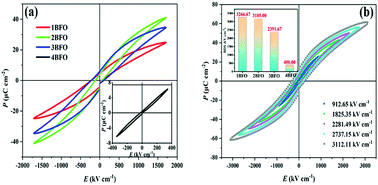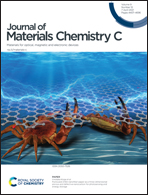High energy storage density with high power density in Bi0.2Sr0.7TiO3/BiFeO3 multilayer thin films†
Abstract
Ferroelectric thin film capacitors with outstanding energy storage performances and fast charge/discharge speed have aroused the attention of researchers due to the development towards the minimization and integration of advanced electronic devices. Herein, environmentally friendly Bi0.2Sr0.7TiO3/BiFeO3 multilayer thin films with different BFO layers have been designed and constructed on Pt(111)/Ti/SiO2/Si substrates by sol–gel/spin coating method. An enhanced polarization and large breakdown strength are simultaneously achieved in the 2BFO multilayer thin film caused by the synergistic effect of multiple polar structures, electric field amplifying effect and interfacial effect, which leads to an ultrahigh energy storage density of ∼50.9 J cm−3 accompanying an efficiency of ∼52.84%. Moreover, the P–E loops of the 2BFO sample are ultra-stable, and no obvious deterioration of the energy storage performances is observed in the wide operating temperature ranges (35–140 °C). The 2BFO capacitor possesses a fast charge/discharge speed of ∼1.5 μs and a giant power density of ∼45.195 MW cm−3, which are superior to that of the commercial BOPP capacitor. The excellent energy storage characteristics make the 2BFO multilayer thin film a promising candidate for energy storage applications.



 Please wait while we load your content...
Please wait while we load your content...